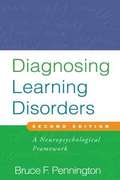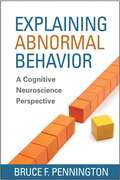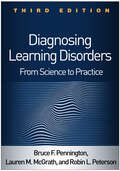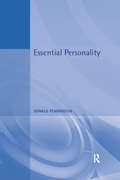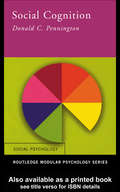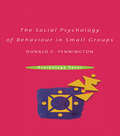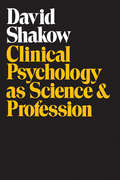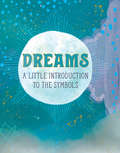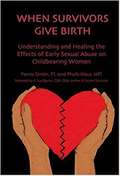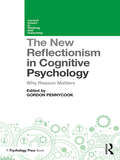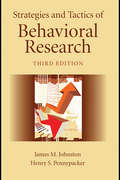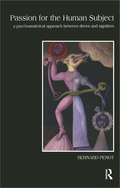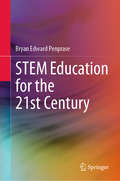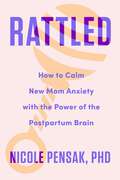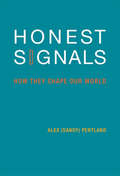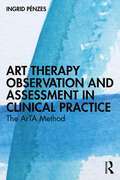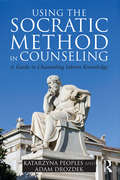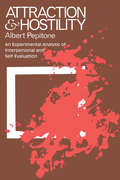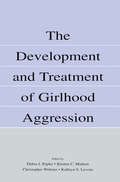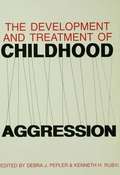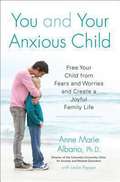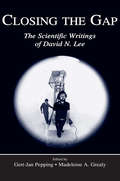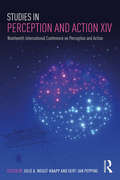- Table View
- List View
Diagnosing Learning Disorders, Second Edition
by Bruce PenningtonFrom a trusted expert in the field, this authoritative work provides an accessible overview of what learning disorders are, how they develop, and how to diagnose and treat them effectively. The author presents the most current neuroscientific knowledge on a range of conditions, including dyslexia, autism spectrum disorders, attention-deficit/hyperactivity disorder, and others. Practitioners gain vital insights and tools for making sense of children's impairments and strengths, collecting and interpreting diagnostic data from a variety of sources, and linking diagnosis to evidence-based interventions. The second edition has been substantially revised and expanded to reflect significant clinical and research advances. New to This Edition Covers additional disorders intellectual disability, mathematics disorder, and developmental coordination disorder, plus a chapter on less well-validated disorders. New case illustrations and a focus on empirically based practice. Now grounded in a multiple cognitive-deficit model of learning disorders, replacing the prior edition's modular, single-deficit model. An illuminating chapter on controversial therapies separates myths from facts.
Explaining Abnormal Behavior: A Cognitive Neuroscience Perspective
by Bruce F. PenningtonHighly readable and accessible, this book describes how research in cognitive science is transforming the way scientists and clinicians think about abnormal behavior. Bruce Pennington draws on work from multiple disciplines to identify compelling links among psychiatric, neurodevelopmental, and neurological disorders that are not generally studied together. Presenting cutting-edge work on the brain systems involved in key domains of neuropsychological functioning, Pennington sheds light on acquired neurological disorders like aphasia and amnesia, as well as the development of such conditions as schizophrenia, depression, dyslexia, autism, and intellectual disability. The book also reveals how the analysis of both typical and atypical brain-behavior relationships can contribute to a neural explanation of the self and consciousness.
Explaining Abnormal Behavior
by Bruce F. PenningtonHighly readable and accessible, this book describes how research in cognitive science is transforming the way scientists and clinicians think about abnormal behavior. Bruce Pennington draws on work from multiple disciplines to identify compelling links among psychiatric, neurodevelopmental, and neurological disorders that are not generally studied together. Presenting cutting-edge work on the brain systems involved in key domains of neuropsychological functioning, Pennington sheds light on acquired neurological disorders like aphasia and amnesia, as well as the development of such conditions as schizophrenia, depression, dyslexia, autism, and intellectual disability. The book also reveals how the analysis of both typical and atypical brain-behavior relationships can contribute to a neural explanation of the self and consciousness.
Diagnosing Learning Disorders, Third Edition: From Science to Practice
by Bruce F. Pennington Lauren M. McGrath Robin L. PetersonA definitive reference--now extensively revised with 70% new material--this book presents cutting-edge knowledge on how learning disorders develop and how to diagnose and treat them effectively. In additional to dyslexia and mathematics disabilities, the book covers speech and language disorders, attention-deficit/hyperactivity disorder, autism spectrum disorder, and intellectual disability. Accessibly written, it is grounded in genetics, neuroscience, and developmental neuropsychology. Clinicians and educators are guided to make sense of children's impairments and strengths and make sound diagnostic decisions. Best practices in intervention are reviewed. User-friendly features include case examples and summary tables in each disorder-specific chapter. New to This Edition *Revised throughout to reflect major theoretical, empirical, and technological advances. *Chapters on etiology, brain development, and comorbidity. *Chapters on DSM-5 diagnosis of specific learning disorder, evidence-based assessment, and achievement gaps.
Essential Personality (Essential Psychology)
by Donald Pennington'Essential Personality' provides a clear, accessible and systematic introduction to the major theoretical approaches for the understanding of human personality. This introductory book assumes no prior knowledge of this core area in psychology and is written for students studying personality for the first time, whether at `A' level, first year undergraduates on psychology degree programmes or students on other courses (for example, nursing, social work or criminology).Each chapter considers one or more of the major approaches to personality. For each approach, a brief biographical outline of the originating theorist is given. This is followed by clear and straightforward descriptions of the major aspects of each theory together with clear definitions of key concepts, and concludes with an evaluation section that addresses the 'model' of humans underlying the approach, research evidence in support of the theory and questioning the theory. Discussion is also given to personality assessment and therapeutic applications of the theory or approach.The individual chapters provide figures, diagrams and tables to give a clear understanding of theory and research. and at the end of each chapter, a summary and suggestions for further reading is provided. A glossary at the end of the book provides definitions and explanations of key items, concepts etc.
Social Cognition (Routledge Modular Psychology)
by Donald C. PenningtonSocial Cognition looks at the way in which humans interpret, analyse and remember information about the social world. Topics covered include: attribution, social schemas and social representations, prejudice and discrimination. Suitable for the AQA-A A2 and AQA-B AS level examintation, mnd students studying social cognition for the first time at undergraduate level.Series DetailsThe Routledge Modular Psychology Series is a completely new approach to introductory level psychology, tailor-made for the new modular style of teaching. Each book covers a topic in more detail than any large textbook can, allowing teacher and student to select material exactly to suit any particular course or project. Especially written for those students new to higher-level study, whether at school, college or university, the books include the following designed features to help with technique: Practice essays with specialist commentary to show how to achieve a higher grade Chapter summaries and summaries of key research Glossary and further reading Progress and review exercises.
The Social Psychology of Behaviour in Small Groups (Psychology Focus Ser.)
by Donald C. PenningtonThe Social Psychology of Behaviour in Small Groups covers theories of group behaviour and their application in organizational psychology. Topics include the structure and formation of groups and the roles that individuals play within groups, as well as more applied areas such as co-operation and conflict, teamwork, leadership and decision-making in small groups.Throughout the book theory, research and concepts are applied to real-life and everyday social behaviour. The book is well illustrated and includes many mental exercises to engage the reader. Donald Pennington has provided a lively, accessible and systematic text suitable for undergraduates studying social psychology and those studying organizational psychology on psychology and business studies courses.
Clinical Psychology as Science and Profession
by J. Roland PennockOne man alone cannot construct an entire profession, but David Shakow is one of the architects responsible for shaping clinical psychology into the profession it is today. Reflecting the ideas of a man whose name is synonymous with the field, this volume brings together for the first time his most significant papers in this area and presents a comprehensive, far-reaching overview of clinical psychology addressed to all of its professionals and students.Dr. Shakow's forty years of influence as a clinician, training program administrator, professor, researcher, and public servant are profoundly reflected in these papers. They offer insight into the work and world of the clinician, the nature of training programs, the history and development of the profession, and the relationship between clinical psychology and other disciplines. Not simply a descriptive record of one man's achievements, the thinking mirrored in this volume is pertinent, even crucial, to the future development of the field.The author's persistent and continuing concern for top quality in training and practice pervades these essays, making them a unified chronicle of the professional growth of clinical psychology and of a master professional's ideas and involvements with the problems and issues in his field. No clinician or student can fully understand the nature of the field, how it came to be, and where it is going, without reading this volume.
Dreams: A Little Introduction to the Symbols (RP Minis)
by Mara PennyExplore the magic of dream interpretation in this fully-illustrated, A-to-Z guide to the symbols and their meanings.From symbols of success and happiness -- like frogs, horses, and kangaroos -- to signs that predict lasting friendships -- including candles and butterflies -- this useful, palm-sized mini-book is an enchanted guide to the symbols and interpretations of dreams. With full-color illustrations throughout, this captivating primer covers more than 90 of the most common images that arise in our dreams.
When Survivors Give Birth: Understanding and Healing the Effects of Early Sexual Abuse on Childbearing Women
by Penny Simkin; Phyllis Klaus<p>When Survivors Give Birth is written for a mixed audience of maternity care professionals and para-professionals, mental health therapists and counselors, and women survivors and their families. The authors expertly and compassionately address the unusual and distressing challenges that arise for abuse survivors during the childbirth experience. <p>The first section informs the reader of the impact of early sexual abuse on children, adults, and on all aspects of childbearing. The second section teaches skills in communication, self-help skills, counseling and psychotherapy techniques. The third covers clinical challenges and solutions for doctors, nurses, midwives, doulas, and others. Case histories throughout the book clarify and apply the content.</p>
The New Reflectionism in Cognitive Psychology: Why Reason Matters (Current Issues In Thinking And Reasoning Ser.)
by Gordon PennycookThis volume presents detailed reviews and will be of use to anyone interested in the strengths and weaknesses of human reason. This volume will also be of use to both proponents and skeptics of dual-process theory as it represents a strong case for the wide theoretical significance of the distinction between intuition and reflection. The empirical evidence indicates that analytic thinking plays a significant role in everyday life. Reason does, in fact, matter.
Strategies and Tactics of Behavioral Research, Third Edition
by Henry S. Pennypacker James M. JohnstonAlmost entirely rewritten and reformatted with many more learning tools, this classic text now has even greater appeal to today's students. This edition features much more discussion of how research methods are relevant for practitioners, and many examples are based on field research and service delivery scenarios. This comprehensive treatment of single-subject or within-subject design focuses on the strategic (the overall goal) and tactical (the methods and procedures) options available to investigators as they try to determine the most effective way of addressing research questions. The authors guide readers to consider the rationale for different ways of measuring behavior and designing experimental comparisons. At every point, the text explains the strengths and weaknesses of alternative choices so that readers can make the best decision in each situation. Highlights of the new third edition include: Rewritten in a straightforward and accessible style for students without a background in this area, this edition features many more field-based examples and applications. Increased focus on the application of research methods to the needs of practitioners in measuring behavior change and evaluating interventions under field conditions. Increased use of learning aids, including a "built-in study guide," summary tables, figures, boxed discussions of special topics, key terms with definitions, chapter summaries, suggested readings, discussion questions and exercises, and a glossary. Instructor's resource materials available on a password-protected website with digital access to figures, tables, definition of new terms by chapters, multiple choice test questions, and content from the book's learning aids, including study guide questions and suggested topics for class discussion and exercises. With a focus on direct behavioral measurement and within-subject design, this book is intended for advanced undergraduate or graduate courses in behavioral research methods, basic or applied behavior analysis, or single-/within-subject design taught in psychology (especially clinical and counseling psychology), social work, education, developmental disabilities, and other social and health science programs that deal with human behavior in research or practice settings. Although the book is written for students without a background in behavioral research, its comprehensive approach to designing procedures for measuring behavior and creating experimental comparisons also make it a valuable resource for investigators and professionals.
Passion for the Human Subject: A Psychoanalytical Approach Between Drives and Signifiers
by Bernard PenotEach one of us has to be born "inter urinas et faeces", as St. Augustine so strikingly put it. More recently, Freud's 1915 discovery of 'instincts' - that is, 'drives' - and their 'viscitudes' leads us further to envision a human subjectivity that would have nothing mataphysical about it. The baby's "feeling of himself" first arises in the midst of the earliest interactions with his parental partner, establishing his 'drive monatges' whose acomplishment forms a circuit latching on to something in the first other. In the course of these early interactions, the 'new subject' evoked by Freud will gradually take on its own qualities, accoridng to the signifcations that it can grasp in the primordial partner's messages, responding to the baby's manifestation of needs. One of Lacan's key ideas is that 'signifiers' are percieved first of all in the Other. The Freudian subject may then be defined as 'an agent of corporeal energy caught up in a signifying relation with his parental other (already a subject)'.
STEM Education for the 21st Century (Springerbriefs In Education Ser.)
by Bryan Edward PenpraseThis book chronicles the revolution in STEM teaching and learning that has arisen from a convergence of educational research, emerging technologies, and innovative ways of structuring both the physical space and classroom activities in STEM higher education. Beginning with a historical overview of US higher education and an overview of diversity in STEM in the US, the book sets a context in which our present-day innovation in science and technology urgently needs to provide more diversity and inclusion within STEM fields. Research-validated pedagogies using active learning and new types of research-based curriculum is transforming how physics, biology and other fields are taught in leading universities, and the book gives profiles of leading innovators in science education and examples of exciting new research-based courses taking root in US institutions. The book includes interviews with leading scientists and educators, case studies of new courses and new institutions, and descriptions of site visits where new trends in 21st STEM education are being developed. The book also takes the reader into innovative learning environments in engineering where students are empowered by emerging technologies to develop new creative capacity in their STEM education, through new centers for design thinking and liberal arts-based engineering. Equally innovative are new conceptual frameworks for course design and learning, and the book explores the concepts of Scientific Teaching, Backward Course Design, Threshold Concepts and Learning Taxonomies in a systematic way with examples from diverse scientific fields. Finally, the book takes the reader inside the leading centers for online education, including Udacity, Coursera and EdX, interviews the leaders and founders of MOOC technology, and gives a sense of how online education is evolving and what this means for STEM education. This book provides a broad and deep exploration into the historical context of science education and into some of the cutting-edge innovations that are reshaping how leading universities teach science and engineering. The emergence of exponentially advancing technologies such as synthetic biology, artificial intelligence and materials sciences has been described as the Fourth Industrial Revolution, and the book explores how these technologies will shape our future will bring a transformation of STEM curriculum that can help students solve many the most urgent problems facing our world and society.
Rattled: How to Calm New Mom Anxiety with the Power of the Postpartum Brain
by Nicole Pensakmatrescence noun /mæ'tres.?nts/ the process of becoming a mother: The physical, psychological, and emotional changes you go through after the birth of your child . . . largely unexplored in the medical community. —Cambridge Dictionary Most new mothers bring their infants to the doctor but ignore any distressing feelings or sensations they might themselves have—that sense of being “rattled” at many moments throughout the day and night. In Rattled, Dr. Nicole Pensak shares her own experiences and those of her patients to help new mothers feel informed, validated, and guided through matrescence. After giving birth, a woman often feels like a completely different person. It may sound dramatic, but the rollercoaster of physical and psychological changes affects brain and body in a similar way that adolescence changes us. To compound that, many women hide these feelings, worrying that something is wrong with them. Dr. Nicole Pensak is here to reassure us that being “rattled” is normal, and not at all surprising. After all, seismic changes in identity and emotion have occurred. Research shows that a woman’s brain shifts in real, biological ways very quickly after giving birth. Many women become hypervigilant, for good reason: the brain is telling her to stay alert because she has a human to keep alive and safe. While these brainpower boosts can cause anxious feelings, they can also help to manage the distress and harness the advantages of the postpartum brain. In fact, this is a time of neuroplasticity, when the brain is more receptive to positive reinforcement. Trained at Yale and Harvard and certified in perinatal mental health, Dr. Pensak provides practical and emotional support, helping to relieve the anxiety and pressure for perfection in motherhood and paving the way for a better beginning for families and babies. She discusses mental health treatment and the upside of therapy during this changing time, and offers accessible scientific information, relatable anecdotes, and strategies for self-care. The result is a reassuring and practical handbook that new mothers and their families will refer to time and again.
Honest Signals: How They Shape Our World (The\mit Press Ser.)
by Alex PentlandHow understanding the signaling within social networks can change the way we make decisions, work with others, and manage organizations.How can you know when someone is bluffing? Paying attention? Genuinely interested? The answer, writes Alex Pentland in Honest Signals, is that subtle patterns in how we interact with other people reveal our attitudes toward them. These unconscious social signals are not just a back channel or a complement to our conscious language; they form a separate communication network. Biologically based “honest signaling,” evolved from ancient primate signaling mechanisms, offers an unmatched window into our intentions, goals, and values. If we understand this ancient channel of communication, Pentland claims, we can accurately predict the outcomes of situations ranging from job interviews to first dates.Pentland, an MIT professor, has used a specially designed digital sensor worn like an ID badge—a “sociometer”—to monitor and analyze the back-and-forth patterns of signaling among groups of people. He and his researchers found that this second channel of communication, revolving not around words but around social relations, profoundly influences major decisions in our lives—even though we are largely unaware of it. Pentland presents the scientific background necessary for understanding this form of communication, applies it to examples of group behavior in real organizations, and shows how by “reading” our social networks we can become more successful at pitching an idea, getting a job, or closing a deal. Using this “network intelligence” theory of social signaling, Pentland describes how we can harness the intelligence of our social network to become better managers, workers, and communicators.
Honest Signals
by Alex Sandy PentlandHow can you know when someone is bluffing? Paying attention? Genuinely interested? The answer, writes Sandy Pentland in Honest Signals,is that subtle patterns in how we interact with other people reveal our attitudes toward them. These unconscious social signals are not just a back channel or a complement to our conscious language; they form a separate communication network. Biologically based "honest signaling," evolved from ancient primate signaling mechanisms, offers an unmatched window into our intentions, goals, and values. If we understand this ancient channel of communication, Pentland claims, we can accurately predict the outcomes of situations ranging from job interviews to first dates. Pentland, an MIT professor, has used a specially designed digital sensor worn like an ID badge--a "sociometer"--to monitor and analyze the back-and-forth patterns of signaling among groups of people. He and his researchers found that this second channel of communication, revolving not around words but around social relations, profoundly influences major decisions in our lives--even though we are largely unaware of it. Pentland presents the scientific background necessary for understanding this form of communication, applies it to examples of group behavior in real organizations, and shows how by "reading" our social networks we can become more successful at pitching an idea, getting a job, or closing a deal. Using this "network intelligence" theory of social signaling, Pentland describes how we can harness the intelligence of our social network to become better managers, workers, and communicators.
Art Therapy Observation and Assessment in Clinical Practice: The ArTA Method
by Ingrid PénzesThis book describes ArTA, an evidence-based method for art therapy observation and assessment. This novel method argues the art-making process and art product are related to aspects of mental health. The results of the author’s own research show that observed patterns in material interaction, material experience, and the specific combinations of formal elements of the art product reveal the client’s balance between thinking and feeling, and adaptability. Divided into four sections, the book illustrates this research, theory, and application of the ArTA method using examples and case histories with clear frameworks that give guidance in art therapy observation and assessment. It provides direction for formulating treatment goals and drawing up appropriate treatment interventions. Intended for art therapy students and practicing art therapists, this methodology will challenge readers to rethink the relationship between a client’s interaction with art materials and their mental health.
Using the Socratic Method in Counseling: A Guide to Channeling Inborn Knowledge
by Katarzyna Peoples Adam DrozdekUsing the Socratic Method in Counseling shows counselors how to use the Socratic method to help clients solve life problems using knowledge they may not realize they have. Coauthored by two experts from the fields of philosophy and counseling, the book presents theory and techniques that give counselors a client-centered and contextually bound method for better addressing issues of ethnicities, genders, cultures. Readers will find that Using the Socratic Method in Counseling is a thorough and useful text on a new theoretical orientation grounded in ancient philosophy.
Attraction and Hostility: An Experimental Analysis of Interpersonal and Self Evaluation
by Albert PepitoneAttraction and hostility find expression in almost every variety of human relationship, and have consequently provided a central theme for social psychology since its beginnings. Yet attempts to conceptualize the diverse phenomena embraced in these terms have produced theories of such wide generality that they have little explanatory or predictive force. The object of the present study is to bring precision to a vast and sprawling area by setting limits and dimensions to the phenomena and investigating them experimentally on the basis of a series of hypotheses derived from a critical analysis of current conceptual approaches, including frustration, need-satisfaction, and dissonance models.The programme of experimental studies focuses on cognitive validation-a motivation to form and maintain subjectively valid evaluations of the self and the social environment-which is shown to be a common denominator of a number of attraction and hostility measures. The results throw light on reactions to boastfulness and to self-debasement; impressions of persons who are described by biased informants; effects of self-evaluation on competitiveness, and the projection of unfavourable characteristics.The interest of the study for social psychologists derives both from its theoretical integration of a wide range of behaviour and from its contribution to experimental design.
The Development and Treatment of Girlhood Aggression
by Debra J. Pepler Kirsten C. Madsen Christopher Webster Kathryn S. LeveneAfter decades of neglect, researchers have begun to focus attention on the development and outcomes of girlhood aggression. This comprehensive volume provides an account of some of the pioneering research in the field. Its central aims are to highlight current understanding, identify key components for preventing and treating the complex array of problems experienced by aggressive girls, and raise new questions for future research. The perspectives presented by the authors highlight the diverse factors that moderate the emergence of aggression while offering insight into how to target that aggression at various stages of development. The problem is presented as a continuum from normative forms of behavior to extreme and serious attacks. The importance of relationships--particularly family relationships--is a theme that permeates the entire volume. A growing body of research indicates that aggression in girls is a predictor of long-term psychological, social, academic, health, and intergenerational problems. The knowledge provided by the authors has tremendous potential to inform practice with troubled girls, their families, and support systems.
The Development and Treatment of Childhood Aggression
by Debra J. Pepler Kenneth H. RubinComprised of papers and commentaries from the Earlscourt Symposium on Childhood Aggression held in Toronto, Canada, this volume reflects the Earlscourt Child and Family Centre's commitment to linking clinical practice to identifiable research-based interventions which are known to be effective in the prevention and treatment of antisocial behavior in children. The education of human services professionals has typically failed to train individuals to work with specific client populations, providing a generalist approach grounded in theoretical assumptions and professional values rather than research and empirical studies. This compelling book serves to fill this gap in professional education in the area of childhood aggression. Representing substantial accomplishments in the advancement of an understanding of the plight of aggressive children and how best to ameliorate their often unpredictable and painful situations, this text allows for cautious optimism that empirical research can have practical consequences for aggressive children and their prospects for a better life. As such, it is a truly important information resource for professionals in the fields of developmental psychology and counseling.
You and Your Anxious Child
by Leslie Pepper Anne Marie AlbanoOne of the world's foremost experts on anxiety in children provides a guide to recognizing and alleviating a range of debilitating fears. Anxiety affects more children and teens than any other psychiatric illness, but it's also the most treatable emotional disorder. Some 25 percent of children and adolescents will suffer an anxiety disorder at several points in their lifetime, resulting in serious problems in their ability to function in school, with peers, and on a general day-to-day basis. A renowned researcher and clinician who has developed groundbreaking, proven coping strategies illuminates a new path to fear-free living for families. You and Your Anxious Child differentiates between separation anxiety, generalized anxiety, and social phobia, and guides parents on when and how to seek intervention. With moving case studies, such as Jon's, whose mother quit her job because his separation anxiety compelled her to stay with him full-time, this book elucidates the nightmare that families can be living, and helps them understand that they are not alone. Every step of the way, Albano illustrates proven therapies to manage anxiety issues in children while addressing the emotional needs of parents, too. You and Your Anxious Child brings much-needed hope to families, helping them shape a positive new vision of the future.
Closing the Gap: The Scientific Writings of David N. Lee
by Gert-Jan Pepping Madeleine A. GrealyThis book is a collection of Lee‘s most important works, placed in a historical setting and contextualized through the commentaries of other leading researchers in the field. The contributors were selected on the basis of their standing in the field. Some have been directly involved in collaborations with Lee, while others have participated in publ
Studies in Perception and Action XIV: Nineteenth International Conference on Perception and Action
by Gert-Jan Pepping Julie A. Weast-KnappICPA provides a forum for researchers and academics who share a common interest in ecological psychology to come together, present new research, and foster ideas towards the advancement of the field. This volume is the fourteenth in the Studies in Perception and Action book series, and highlights research presented at the 19th International Conference of Perception and Action (ICPA) in the summer of 2017. Since 1991, this edited book series has appeared in conjunction with the biennial ICPA meeting. The short papers and empirical articles presented in this book represent the contributions of researchers and laboratories from across the globe. The reader will find new, cutting-edge research on a wide variety of topics in perception and action. This volume will especially appeal to those that are interested in James J. Gibson's ecological approach to psychology, as well as, more broadly, students and researchers of visual and haptic perception, perceptual development, human movement dynamics, human factors, and social processes.
